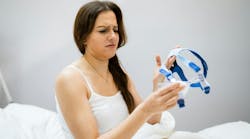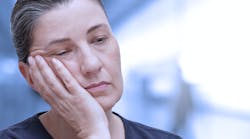A pillar of good health: The detoxifying power of sleep
Listen to the article on our podcast!
We’ve all experienced the adverse effects of poor sleep. There’s a stark difference between restful sleep and reduced quality sleep. Poor nights are often the result of increased caffeine intake or eating high carb snacks or sugary foods, usually in an effort to find a quick energy source.
Sleep is considered a pillar in the functional approach to health. Without proper sleep, we increase the risk of systemic health dysfunction, which leads to an increased chance of disease. As dental hygienists, we can help identify signs and symptoms of a dysfunctional airway that can lead to poor sleep.
The brain detox
Maiken Nedergaard, MD, DMSc, codirector of the Center for Translational Neuromedicine at the University of Rochester Medical Center in New York who led a study, said “Sleep changes the cellular structure of the brain. It appears to be a completely different state. The brain may flush out toxins during sleep.”1
During sleep, hormones such as melatonin are released to slow breathing and relax muscles, which can reduce inflammation. While asleep, the brain opens the channels between cells, allowing more fluid to flow into the brain and remove waste.2 The fluid takes toxins, damaged cells, proteins, and other waste and flushes it to “drainage” sites to be eliminated from the body.2
This process is regulated by cerebrospinal fluid that surrounds the brain and spinal cord through a series of channels surrounded by blood vessels. This is the glymphatic system.2 A recent report from the National Health Institute demonstrates that this system has been shown to remove a toxic protein called beta-amyloid from brain tissue.2 Sleep also regulates cortisol, growth hormones, insulin, and TSH, which regulate the body's functions.
Sleep deprivation
Insufficient sleep has an estimated economic impact of $411 billion annually. Lack of sleep results in unplanned absences from work that cost the US economy $44.6 billion annually.3 Sleep deprivation symptoms include lack of energy, memory trouble, reduced attention span, slow thinking, reduced sex drive, poor decision-making, irritability, and daytime sleepiness.
Sleep deprivation can lead to some chronic diseases and conditions, such as type 2 diabetes, heart disease, obesity, and depression.4 Shockingly, 83% of patients with depression have at least one symptom of airway dysfunction. Glucose tolerance is decreased by more than 40% when subjects suffer from sleep loss.3
We’ve normalized what isn’t normal
I attended a series of courses with Dr. Witt Wilkerson last year. He changed the way I view our chairside role in screening for sleep apnea. I admit I had come to normalize grinding and clenching in patients. More than half of the patients I treat daily have signs of wear, clenching, or a scalloped tongue, all of which are signs of sleep disturbance.
When a patient struggles for oxygen, the brain defaults to clenching or grinding to remind the body to breathe. Additionally, a narrow palate, crowded teeth, tongue ties, neck circumference greater than 17 inches, high BMIs, obesity, waking up at night, difficulty falling asleep, frequent headaches, morning headaches, and inflamed gingiva are all signs of airway dysfunction.3
Chairside assessment
In addition to screening for the factors listed above, the Mallampati score is an easy screening tool to identify whether there is airway dysfunction that will inhibit a patient's ability to detoxify while sleeping.5 The Mallampati score describes the relative size of the base of the tongue compared to the oropharyngeal opening to determine if there’s a difficult airway.
To implement the screening, advise the patient to sit up straight and open their mouth as wide as possible while sticking out their tongue. Examine the patient's throat to identify key landmarks of the soft palate, uvula, and tonsillar pillars. The scores are 1 to 4, with higher scores indicating a greater risk of obstructive sleep apnea.
Class 1: The patient's tonsils, uvula, and soft palate are completely visible.
Class 2: The hard and soft palate, upper tonsils, and uvula are visible.
Class 3: The hard and soft palate are visible; the uvula is somewhat obscured.
Class 4: Only the hard palate is visible.
I do this screening during oral cancer screenings with every patient, every time. The findings have been astonishing; many of my patients were class 3 or 4, and collaboratively with the dentists, we’ve referred them for a sleep test. We’ve found that many patients had normalized their poor sleep, and with the help of a device, they’re now experiencing restorative sleep.
Sleep hygiene
The best way to improve sleep is to create a sleep routine where one goes to bed and wakes up at the same time every day. Natural melatonin—the hormone that the pineal gland releases in response to the darkness—works to regulate sleep.3 But if one’s eyes are locked into a bright light, such as a cell phone, prior to bed, it can inhibit the melatonin from being released.
Experts suggest dimming the lights 15 to 20 minutes before bed, reducing alcohol consumption, exercising daily, getting exposed to the sun within the first 15 minutes of waking, avoiding eating within three hours of sleep when possible, and prioritizing sleep.3 Sleep tracking devices help track the quality of sleep and can help people adjust things such as caffeine intake by tracking a person’s habits.
Every patient and provider deserve to experience restorative, detoxifying sleep. The advancements in the dental profession have allowed us to provide sleep devices for patients, identify and treat tongue ties with laser-assisted therapy, and provide preventive treatment such as myofunctional therapy that supports a healthy airway. When we identify the root cause of a sleep disturbance, we not only improve someone’s quality of life, but we can also change the medical future of that patient.
Editor's note: This article appeared in the June 2024 print edition of RDH magazine. Dental hygienists in North America are eligible for a complimentary print subscription. Sign up here.
References
1. Brain may flush out toxins during sleep. National Institutes of Health. September 17, 2015. www.nih.gov/news-events/news-releases/brain-may-flush-out-toxins-during-sleep
2. How sleep clears the brain. National Institutes of Health. October 28, 2013. www.nih.gov/news-events/nih-research-matters/how-sleep-clears-brain
3. Wilkerson DC, Lestini S, Dawson PE, Bale B. The Shift: The Dramatic Movement toward Health Centered Dentistry. Widiom Publishing. 2019.
4. Kim TW, Jeong JH, Hong SC. The impact of sleep and circadian disturbance on hormones and metabolism. Int J Endocrinol. 2015;2015:591729. doi:10.1155/2015/591729
5. Stutz EW, Rondeau B. Mallampati score. National Library of Medicine. Last update August 5, 2023. www.ncbi.nlm.nih.gov/books/NBK585119/
About the Author

Amber Auger, MPH, RDH
Amber is a dental hygiene clinician, international speaker, and hygiene director who specializes in nonsurgical periodontal therapy, heart-centered education, and efficiency. Through her signature program, Thrive in the OP and Thrive Chairside Summit, she equips hygienists with evidence-based systems to elevate patient outcomes, confidence, and production. Amber blends clinical expertise with practical strategies to help dental teams implement sustainable, science-driven protocols. She can be reached at amberauger.com.


